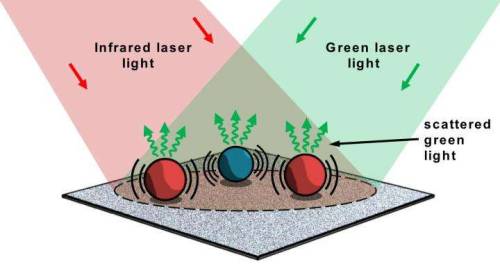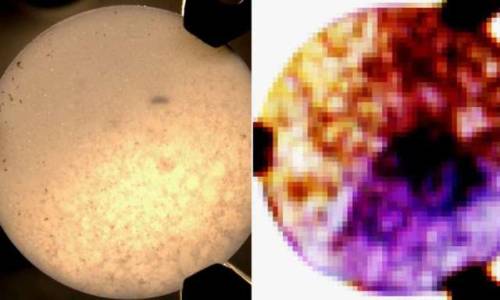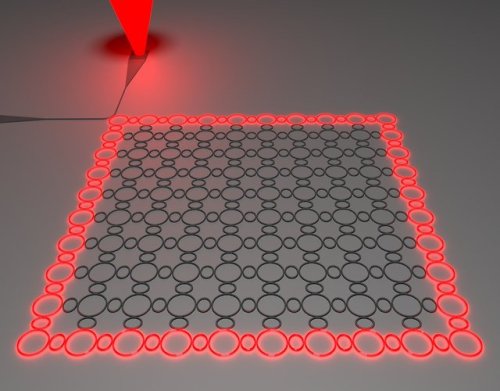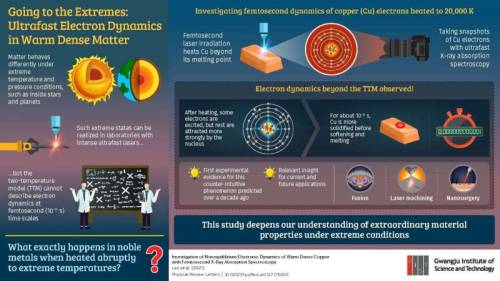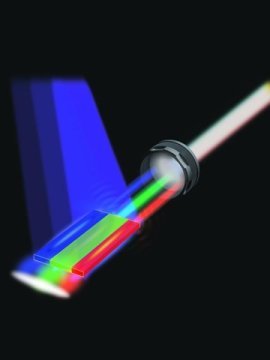#lasers
materialsscienceandengineering:
Giant lasers crystallize water with shockwaves, revealing the atomic structure of superionic ice
Scientists from Lawrence Livermore National Laboratory (LLNL) used giant lasers to flash-freeze water into its exotic superionic phase and record X-ray diffraction patterns to identify its atomic structure for the very first time—all in just a few billionths of a second. The findings are reported today in Nature.
In 1988, scientists first predicted that waterwould transition to an exotic state of matter characterized by the coexistence of a solid lattice of oxygen and liquid-like hydrogen—superionic ice—when subjected to the extreme pressures and temperatures that exist in the interior of water-rich giant planets like Uranus and Neptune. These predictions remained in place until 2018, when a team led by scientists from LLNL presented the first experimental evidence for this strange state of water.
Now, the LLNL scientists describe new results. Using laser-driven shockwaves and in-situ X-ray diffraction, they observe the nucleation of a crystalline lattice of oxygen in a few billionths of a second, revealing for the first time the microscopic structure of superionic ice.
Post link
Exploring the hyperchaos of mid-infrared lasers
Chaos, often popularized as the ‘butterfly effect’, describes the irregular phenomenon of deterministic systems. Based on the unique features of sensitivity to initial conditions and unpredictability of future evolutions, chaos from laser diodes has found applications in private optical communication links, high-rate random number generations, Lidar systems, and optical computing networks. However, most chaotic light sources are operated in the near-infrared range, and hence the applications are limited to this spectral range as well.
A Chinese team of scientists, led by Professor Cheng Wang from ShanghaiTech University, China recently reported a mid-infrared hyperchaos source in Light: Science & Applications. The chaos generation relies on interband cascade lasers, one major type of laser source in the mid-infrared regime. The lasers without any external perturbation usually produce continuous-wave output. In order to trigger the chaos production, the team applied an external perturbation known as 'optical feedback’ to the lasers. Optical feedback is a technique where the laser output is reflected back to the laser cavity through a reflection mirror. The delayed light interacts nonlinearly with the laser device and generates chaos under certain operation conditions.
Post link
Minimizing laser phase noise with machine learning
Ultra-precise lasers can be used for optical atomic clocks, quantum computers, power cable monitoring, and much more. But all lasers make noise, which researchers from DTU Fotonik want to minimize using machine learning.
The perfect laser does not exist. There will always be a bit of phase noise because the laser light frequency moves back and forth a little. Phase noise prevents the laser from producing light waves with the perfect steadiness that is otherwise a characteristic feature of the laser.
Most of the lasers we use on a daily basis do not need to be completely precise. For example, it is of no importance whether the frequency of the red laser light in the supermarket barcode scanners varies slightly when reading the barcodes. But for certain applications—for example in optical atomic clocks and optical measuring instruments—it is absolutely crucial that the laser is stable so that the light frequency does not vary.
One way of getting closer to an ultra-precise laser is if you can determine the phase noise. This may enable you to find a way of compensating for it, so that the result becomes a purer and more accurate laser beam.
Post link
Laser sintering optimized for printed electronics
Printed electronics use standard printing techniques to manufacture electronic devices on different substrates like glass, plastic films, and paper. Interest in this area is growing because of the potential to create cheaper circuits more efficiently than conventional methods. A new study by researchers at Soonchunhyang University in South Korea, published in AIP Advances, provides insights into the processing of copper nanoparticle ink with green laser light.
Kye-Si Kwon and his colleagues previously worked with silver nanoparticle ink, but they turned to copper (derived from copper oxide) as a possible low-cost alternative. Metallic inks composed of nanoparticles hold an advantage over bulk metals because of their lower melting points. Although the melting point of copper is about 1,083 degrees Celsius in bulk, according to Kwon, copper nanoparticles can be brought to their melting point at just 150 to 500 C—through a process called sintering. Then, they can be merged and bound together.
Kwon’s group concentrates on photonic approaches for heating nanoparticles by the absorption of light. “A laser beam can be focused on a very small area, down to the micrometer level,” explained Kwon and doctorate student Md. Khalilur Rahman. Heat from the laser serves two main purposes: converting copper oxide into copper and promoting the conjoining of copper particles through melting.
Post link
First integrated laser on lithium niobate chip
For all the recent advances in integrated lithium niobate photonic circuits—from frequency combs to frequency converters and modulators—one big component has remained frustratingly difficult to integrate: lasers.
Long haul telecommunication networks, data center optical interconnects, and microwave photonic systems all rely on lasers to generate an optical carrier used in data transmission. In most cases, lasers are stand-alone devices, external to the modulators, making the whole system more expensive and less stable and scalable.
Now, researchers from the Harvard John A. Paulson School of Engineering and Applied Sciences (SEAS) in collaboration with industry partners at Freedom Photonics and HyperLight Corporation, have developed the first fully integrated high-power laser on a lithium niobate chip, paving the way for high-powered telecommunication systems, fully integrated spectrometers, optical remote sensing, and efficient frequency conversion for quantum networks, among other applications.
Post link
New microscope chemically identifies micron-sized particles
Researchers have developed a microscope that can chemically identify individual micron-sized particles. The new approach could one day be used in airports or other high-security venues as a highly sensitive and low-cost way to rapidly screen people for microscopic amounts of potentially dangerous materials.
In the journal Optics Letters, from The Optical Society (OSA), researchers from the Massachusetts Institute of Technology’s Lincoln Laboratory, USA, demonstrated their new microscope by measuring infrared spectra of individual 3-micron spheres made of silica or acrylic. The new technique uses a simple optical setup consisting of compact components that will allow the instrument to be miniaturized into a portable device about the size of a shoebox.
“The most important advantage of our new technique is its highly sensitive, yet remarkably simple design,” said Ryan Sullenberger, associate staff at MIT Lincoln Labs and first author of the paper. “It provides new opportunities for nondestructive chemical analysis while paving the way towards ultra-sensitive and more compact instrumentation.”
Post link
Researchers improve semiconductor laser on silicon
Electrical engineering researchers have boosted the operating temperature of a promising new semiconductor laser on silicon substrate, moving it one step closer to possible commercial application.
The development of an “optically pumped” laser, made of germanium tin grown on silicon substrates, could lead to faster micro-processing speed of computer chips, sensors, cameras and other electronic devices—at much lower cost.
“In a relatively short time period—roughly two years—we’ve progressed from 110 Kelvin to a record temperature of 270K,” said Shui-Qing “Fisher” Yu, associate professor of electrical engineering. “We are now very close to room-temperature operation and moving quickly toward the application of a material that can significantly increase processing speed with much less power consumption.”
Yu leads a multi-institutional team of researchers on developing a laser injected with light, similar to an injection of electrical current. The improved laser covers a broader wavelength range, from 2 to 3 micrometers, and uses a lower lasing threshold, while capable of operating at 270 Kelvin, which is roughly 26 Farenheit.
Post link
Closing the terahertz gap: Tiny laser is an important step toward new sensors
In a major step toward developing portable scanners that can rapidly measure molecules in pharmaceuticals or classify tissue in patients’ skin, researchers have created an imaging system that uses lasers small and efficient enough to fit on a microchip.
The system emits and detects electromagnetic radiationatterahertz frequencies—higher than radio waves but lower than the long-wave infrared light used for thermal imaging. Imaging using terahertzradiation has long been a goal for engineers, but the difficulty of creating practical systems that work in this frequency range has stymied most applications and resulted in what engineers call the “terahertz gap.”
“Here, we have a revolutionary technology that doesn’t have any moving parts and uses direct emission of terahertz radiation from semiconductor chips,” said Gerard Wysocki, an associate professor of electrical engineering at Princeton University and one of the leaders of the research team.
Terahertz radiation can penetrate substances such as fabrics and plastics, is non-ionizing and therefore safe for medical use, and can be used to view materials difficult to image at other frequencies. The new system, described in a paper published in the June issue of the journal Optica, can quickly probe the identity and arrangement of molecules or expose structural damage to materials.
Post link
Transforming materials with light: Study could lead to ultrafast light-based computers and more
Imagine windows that can easily transform into mirrors, or super high-speed computers that run not on electrons but light. These are just some of the potential applications that could one day emerge from optical engineering, the practice of using lasers to rapidly and temporarily change the properties of materials.
“These tools could let you transform the electronic properties of materials at the flick of a light switch,” says Caltech Professor of Physics David Hsieh. “But the technologies have been limited by the problem of the lasers creating too much heat in the materials.”
In a new study in Nature, Hsieh and his team, including lead author and graduate student Junyi Shan, report success at using lasers to dramatically sculpt the properties of materials without the production of any excess damaging heat.
“The lasers required for these experiments are very powerful so it’s hard to not heat up and damage the materials,” says Shan. “On the one hand, we want the material to be subjected to very intense laser light. On the other hand, we don’t want the material to absorb any of that light at all.” To get around this the team found a “sweet spot,” Shan says, where the frequency of the laser is fine-tuned in such a way to markedly change the material’s properties without imparting any unwanted heat.
Post link
Making lasers more efficient, versatile and compact
Their inner workings reside in the realm of physics, but lasers make everyday life possible. Talking on a cell phone or googling COVID stats while your apples and oranges are scanned at the checkout counter—lasers at every step.
Lasers emit intense light at specific wavelengths. At one wavelength, laser beams etch patterns on computer chips that define their circuitry. At telecom wavelengths, lasers fire the enormous volumes of data through optical fibers that make ours the information age.
In 2017, a new kind of laser invented by electrical engineer Boubacar Kante, Ph.D., was recognized as one of the breakthrough inventions of the year by Physics World. With his Bakar Fellows support, Kante is preparing to fabricate a prototype of the new laser and demonstrate its potential for a range of applications from microsurgery to satellite telemetry.
Boubacar, an associate professor of electrical engineering and computer sciences, describes the novel capabilities of the new laser technology.
Post link
X-ray laser reveals how radiation damage arises
An international research team has used the X-ray laser European XFEL to gain new insights into how radiation damage occurs in biological tissue. The study reveals in detail how water molecules are broken apart by high-energy radiation, creating potentially hazardous radicals and electrically charged ions, which can go on to trigger harmful reactions in the organism. The team led by Maria Novella Piancastelli and Renaud Guillemin from the Sorbonne in Paris, Ludger Inhester from DESY and Till Jahnke from European XFEL is presenting its observations and analyses in the scientific journal Physical Review X.
Sincewater is present in every known living organism, the splitting of the water molecule H2O by radiation, called the photolysis of water, is often the starting point for radiation damage. “However, the chain of reactions that can be triggered in the body by high-energy radiation is still not fully understood,” explains Inhester. “For example, even just observing the formation of individual charged ions and reactive radicals in water when high-energy radiation is absorbed is already very difficult.”
To study this sequence of events, the researchers shot the intense pulses from the X-ray laser at the water vapor. Water molecules normally disintegrate on absorbing a single such high-energy X-ray photon. “Due to the particularly intense pulses from the X-ray laser, it was even possible to observe water molecules absorbing not just one, but two or even more X-ray photons before their debris flew apart,” Inhester reports. This gives the researchers a glimpse of what goes on inside the molecule after the first absorption of an X-ray photon.
Post link
Two-color X-rays give scientists 3-D view of the unknown
A high-resolution view of a sample or details of the first steps in ultra-fast processes are now available, thanks to researchers at SLAC National Accelerator Laboratory’s Linac Coherent Light Source (LCLS). They incorporated a series of advances to hit samples with a pair of precisely tuned X-ray laser pulses of different colors, or photon energies. The two pulses can arrive at the same time providing a detailed three-dimensional view of the sample’s structure. Delaying the beams by tens of femtoseconds (quadrillionths of a second) allows scientists to study very fast processes, such as the earliest steps of a chemical reaction.
For the first time, X-ray scientists have access and independent control of ultra-short two-color X-ray pulses with nearly the full peak power of the LCLS (above 50 GW). This new capability represents an improvement by an order of magnitude over what was possible before making it easier and faster for scientists to better dissect hard-to-study chemical and material science samples as well as map medically important proteins, such as signaling proteins of interest as pharmaceutical targets.
At the LCLS, researchers have demonstrated the generation of two-color X-ray pulses using twin electron bunches. In this technique, two electron bunches are generated by illuminating the injector photocathode with a train of two laser pulses separated in time by a few picoseconds. After being accelerated and compressed, the two electron bunches are spaced by tens of femtoseconds and have two distinct energies. When the high brightness bunched electron beams are delivered to a sequence of alternating magnets called an undulator, the two bunches emit two independent X-ray pulses of different photon energies.
Post link
Applying topological physics to lasing creates more highly efficient and robust lasers
Israeli and US researchers have developed a new, highly efficient coherent and robust semiconductor laser system: the topological insulator laser.
The findings are presented in two new joint research papers, one describing theory and the other experiments, published online today by the prestigious journal Science.
Topological insulators are one of the most innovative and promising areas of physics in recent years, providing new insight into the basic understanding of protected transport. These are special materials that are insulators in their interior but conduct a “super-current” on their surface: the current on their surface is not affected by defects, sharp corners or disorder; it continues unidirectionally without being scattered.
The studies were conducted by Professor Mordechai Segev, of The Technion–Israel Institute of Technology, and his team: Dr. Miguel A. Bandres and Gal Harari, in collaboration with Professors Demetrios N. Christodoulides and Mercedeh Khajavikhan and their students Steffen Wittek, Midya Parto and Jinhan Ren at CREOL, College of Optics and Photonics, University of Central Florida, together with scientists from the US and Singapore.
Post link
Scientists reveal ultrafast melting dynamics in matter heated to extreme temperatures
Ordinary matter behaves very differently when subjected to extreme temperatures and pressures, such as that inside stellar and planetary cores. Conventional rules of condensed matter physics and plasma physics are not applicable in such scenarios. In particular, an extreme state known as “warm dense matter” (WDM) straddles the boundary of condensed matter physics and plasma physics.
One might think that such states can never be created in a terrestrial setting. But, in fact, short laser pulses that are only femtoseconds (10-15 s, or a quadrillionth of a second) long are intense enough to recreate such conditions in a laboratory. Conventional physical models that describe such states typically assume that electrons become excited by the laser pulse attain equilibrium within tens of femtoseconds while the ions remain “cold.” However, in doing so, the non-equilibrium dynamics of the electrons are completely disregarded.
Post link
World’s first white lasers demonstrated
While lasers were invented in 1960 and are commonly used in many applications, one characteristic of the technology has proven unattainable. No one has been able to create a laser that beams white light.
Researchers at Arizona State University have solved the puzzle. They have proven that semiconductor lasers are capable of emitting over the full visible color spectrum, which is necessary to produce a white laser.
The researchers have created a novel nanosheet – a thin layer of semiconductor that measures roughly one-fifth of the thickness of human hair in size with a thickness that is roughly one-thousandth of the thickness of human hair–with three parallel segments, each supporting laser action in one of three elementary colors. The device is capable of lasing in any visible color, completely tunable from red, green to blue, or any color in between. When the total field is collected, a white color emerges.
The researchers, engineers in ASU’s Ira A. Fulton Schools of Engineering, published their findings in the July 27 advance online publication of the journal Nature Nanotechnology. Cun-Zheng Ning, professor in the School of Electrical, Computer and Energy Engineering, authored the paper, “A monolithic white laser,” with his doctoral students Fan Fan, Sunay Turkdogan, Zhicheng Liu and David Shelhammer. Turkdogan and Liu completed their Ph.Ds. after this research.
Post link
From their use in telecommunication to detecting hazardous chemicals, lasers play a major role in our everyday lives. They keep us connected, keep us safe, and allow us to explore the dark corners of the universe. Now a Northwestern Engineering team has made this ever-important tool even simpler…
Infrared lasers reveal unprecedented details in surface scattering of methane
When molecules interact with solid surfaces, a whole range of dynamic processes can take place. These are of enormous interest in the context of catalytic reactions, e.g. the conversion of natural gas into hydrogen that can then be used to generate clean electricity.
Specifically, the interaction of methanemolecules with catalyst surface such as nickel is of interest if we are to gain a detailed and meaningful understanding of the process on a molecular level. But studying scattering dynamics of polyatomic molecules such as methane has been challenging because current detection techniques are unable to resolve all the quantum states of the scattered molecules.
The lab of Rainer Beck at EPFL has now used novel infrared laser techniques to study methane scattering on a nickel surface for the first time with full quantum-state resolution. Quantum-state resolved techniques have contributed much to our understanding of surface-scattering dynamics, but the innovation here was that the EPFL team was able to extend such studies to methane by combining infrared lasers with a cryogenic bolometer: a highly sensitive heat detector cooled to 1.8 K that can pick up the kinetic and internal energy of the incoming methane molecules.
Post link
Mystery: The deuteron, just like the proton, is much smaller than previously thought
The deuteron – one of the simplest atomic nuclei, consisting of just one proton and one neutron – is considerably smaller than previously thought. This finding was arrived at by an international research group that carried out experiments at the Paul Scherrer Institute, PSI. The new result is consistent with a 2010 study by the same group, in which the researchers measured the proton and found a significantly smaller value than previous research using different experimental methods. The result from 2010 formed the basis for what has been known since then as “the proton radius puzzle.” The new measurement of the deuteron’s size has now given rise to an analogous mystery. It is possible that this will lead to an adjustment of the Rydberg constant, a fundamental quantity in physics. Another possible explanation is that a physical force as yet unknown is at work. For their experiments the researchers used laser spectroscopy to measure so-called muonic deuterium: an artificial atom consisting of a deuteron orbited by an exotic elementary particle known as a muon. The experiments took place at PSI because the world’s most powerful muon source, available here, was needed to produce sufficient muonic deuterium. The researchers have published their new study of the deuteron’s size in the journal Science.
The deuteron is smaller than previous measurements have found. A deuteron is a very simple atomic nucleus made up of just one proton and one neutron – that is, one each of the two nuclear building blocks. An international research collaboration, working at the Paul Scherrer Institute PSI, has measured the deuteron more accurately than ever before. The value they obtained for the radius of the deuteron does not, however, correspond to the measurements of other research groups but instead shows a significantly smaller value.
Post link
Light-emitting nanoparticles could provide a safer way to image living cells
Berkeley Lab scientists show how tiny, metal-rich particles can be excited with a low-power laser for deep-tissue imaging
A research team has demonstrated how light-emitting nanoparticles, developed at the U.S. Department of Energy’s Lawrence Berkeley National Laboratory (Berkeley Lab), can be used to see deep in living tissue.
The specially designed nanoparticles can be excited by ultralow-power laser light at near-infrared wavelengths considered safe for the human body. They absorb this light and then emit visible light that can be measured by standard imaging equipment.
The development and biological imaging application of these nanoparticles is detailed in a study published online Aug. 6 in Nature Communications.
Researchers hope to further develop these so-called alloyed upconverting nanoparticles, or aUCNPs, so that they can attach to specific components of cells to serve in an advanced imaging system to light up even single cancer cells, for example. Such a system may ultimately guide high-precision surgeries and radiation treatments, and help to erase even very tiny traces of cancer.
Post link
Many joining and cutting processes are possible only with lasers. New technologies make it possible to manufacture metal components with hollow structures that are significantly lighter and yet just as stable as solid components. In addition, lasers can be used to combine various lightweight…






